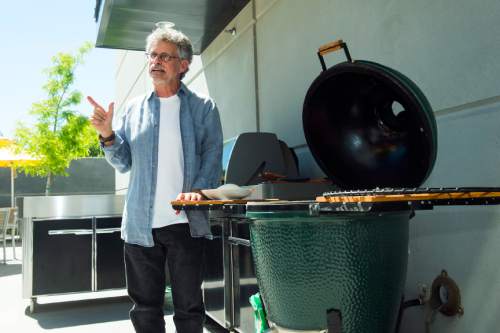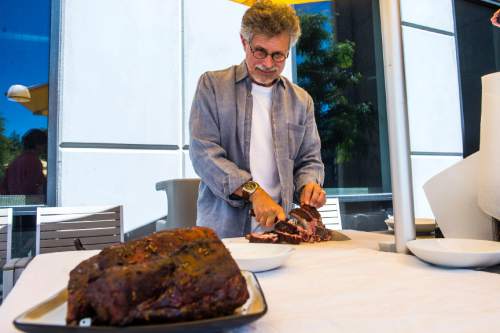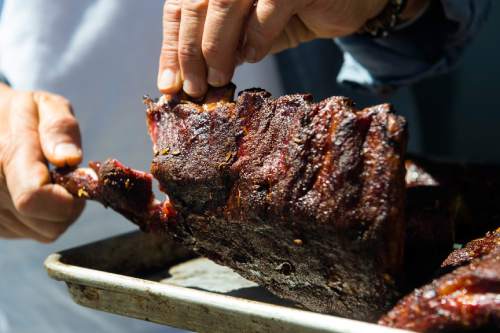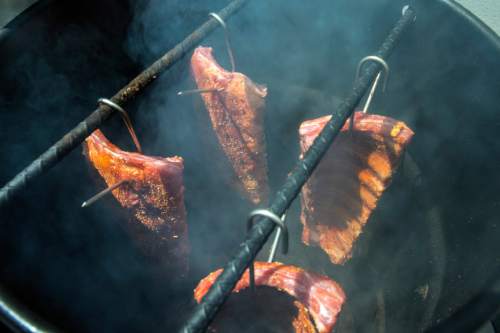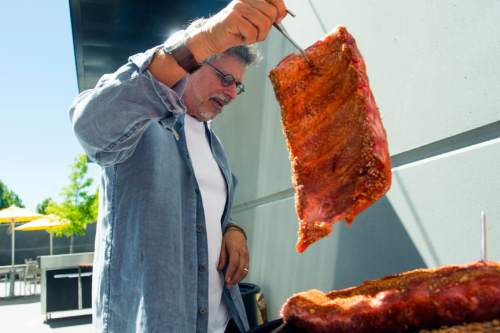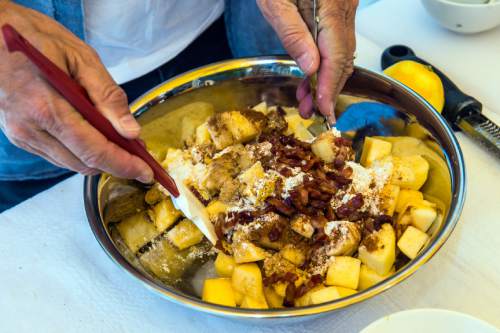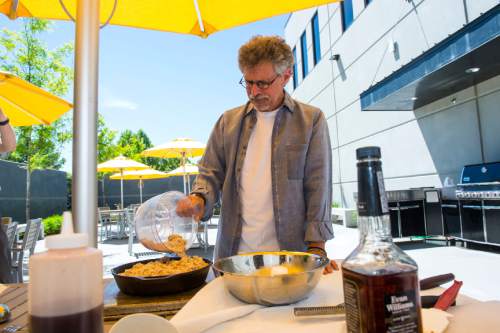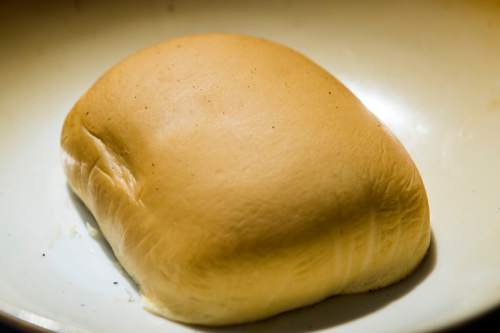This is an archived article that was published on sltrib.com in 2016, and information in the article may be outdated. It is provided only for personal research purposes and may not be reprinted.
There has been an evolution in backyard cooking. First we thought grilling was great. Then barbecue was better. Now smoking is scorching hot.
"Smoking's moment has come," declares outdoor cooking guru Steven Raichlen, the author of some 30 cookbooks, including "The Barbecue Bible" and "How to Grill."
Raichlen was in Utah recently promoting his latest book, "Project Smoke," the same name as his PBS cooking series, now in its second season. Released in time for Father's Day and the peak of outdoor dining, "Project Smoke" covers — as its subtitle suggests — the "seven steps to smoked food nirvana."
It offers a step-by-step guide to smokers, fuels, techniques and the science behind the newest cooking phenomenon. The book ($22.95; Workman Publishing) also has 100 recipes for those who want classics or something more adventurous.
Raichlen said there has been a natural progression in backyard cooking. It used to be that families cooked hamburgers, hot dogs and chicken on the backyard grill and left wood-smoked meats to the professional pit masters working at smokehouses or barbecue joints.
But as our culinary skills became more sophisticated — thanks to the internet, cooking shows and the popularity of barbecue competitions and tours — average cooks came to understand the difference between traditional summer grilling and the "low-and-slow" method of barbecue.
"Smoking takes it to the next level," said Raichlen. "It's the new frontier."
There are a lot of similarities between barbecue and smoking, which sometimes causes confusion. All barbecue is smoked — think brisket, pork shoulder and ribs, he said. But not all smoked foods are barbecued — take smoked salmon, smoked eggs or smoked cheese.
Fueling the fascination of smoked foods has been the advent of new fuels, tools and equipment. All combined, it has put smoking "within reach of every man's backyard," said Raichlen.
And the "umami" flavor that smoke adds to food is the prize, he said. Smoke gives familiar foods an otherworldly quality "that is familiar and exotic at the same time."
While in Utah, Raichlen visited The King's English Bookshop in Salt Lake City, Pat's Barbecue and the Utah County-based ThermoWorks facility where high-tech cooking thermometers for professional and home cooks are manufactured.
He also carved out time for The Salt Lake Tribune. In between smoking three recipes from his book — hay-smoked mozzarella, cherry-glazed baby back ribs and bacon-bourbon apple crisp — he shared five facts about smoking.
1. You may already have a smoker
A tall kettle-style grill with a tight-fitting lid works great for those who want to attempt smoking, but don't want to invest hundreds of dollars in a new smoker. Simply add soaked wood chips (or even hay) — per recipe directions — to the glowing charcoal embers in the grill to generate smoke.
2. Smoking food doesn't have to take all day
There are many foods that don't require a huge time investment. Shrimp takes 30 minutes; a dessert takes about 45 minutes; cheese takes 5.
3. You can smoke more than meat
"Project Smoke" includes recipes for deviled eggs, nachos, potato salad, beans, flan and yes, even cocktails. Liquor and smoke make a natural pairing, Raichlen said, noting that Scotch whiskey is made with smoked barley and for Mezcal, agave is smoke-roasted in a pit before distilling.
4. Don't forget to hydrate your food
Moisture is an essential component of smoking — unless you prefer dry food. Keep the smoking environment moist by either placing a bowl of water in the smoke chamber, spraying food with apple cider or wine, or mopping the food with a sauce.
5. Smoky flavor without a smoker
Bacon, chipotle chiles, Mezcal, pimenton (smoked paprika from Spain), Scotch whiskey or smoked black tea (laapsang souchon) will introduce that smoky flavor people enjoy without all the work.
kathys@sltrib.com
—
Hay-smoked mozzarella
1 (8- to 12-ounce) ball of fresh mozzarella, patted dry
Vegetable oil, to prevent sticking
Extra-virgin olive oil, optional, for serving
Course salt, (sea or kosher) optional, for serving
3 quarts hay (for smoking)*
Place a small amount of charcoal in the smoker firebox or on one side of a kettle grill with a tight-fitting lid and light it. Brush and oil the grate with vegetable oil. When the coals glow red, place the cheese in the smoke chamber (or on the side of the kettle grill opposite the embers) as far away from the fire as possible. Place hay on the coals and close the smoker or cover on the grill. Smoke the cheese until it is colored with smoke, but not long enough to melt, 2 to 4 minutes.
Slide a spatula under the cheese and transfer to a plate to cool. Do not touch the cheese when hot or the smoke will come off on your fingers. Serve once it has cooled to room temperature or refrigerate until serving. (For maximum flavor, let the cheese warm to room temperature before serving.)
Drizzle with olive oil and sprinkle with salt, if desired, before serving.
Use smoked mozzarella in salads, sandwiches or in grilled eggplant Parmesan.
*Small bags of hay are available at garden stores and farm centers.
Servings • 2 to 3 servings
Source: Project Smoke: Seven Steps to Smoked Food Nirvana, by Steven Raichlen
—
Oak-smoked cherry-glazed baby back ribs
4 racks (2-to-2 1/2 pounds each) baby back ribs
5 tablespoons sweet paprika
1/4 cup brown sugar, light or dark
3 tablespoons pimenton (Spanish smoked paprika)
2 tablespoons ground coriander
2 tablespoons fennel seeds
2 tablespoons coarse salt (sea or kosher)
1 tablespoon cayenne pepper
2 teaspoons ground cumin
1 1/2 cups Italian cherry syrup, plus extra as needed. (Torani brand suggested)*
Arrange the ribs on a rimmed baking sheet. Remove the thin, papery membrane from the back of each rack of ribs. (See directions below.)
Combine sweet paprika, brown sugar, smoked paprika, coriander, fennel seeds, salt, cayenne and cumin in a small bowl. Stir to mix, breaking up the lumps in the brown sugar with your fingers.
Sprinkle 1 to 1 1/2 tablespoons of rub on both side of the ribs, rubbing into the meat with your fingertips. (This recipe makes more rub than you'll need. Store the extra in a sealed jar away from heat and light. It will keep for several weeks.)
Set up the smoker following manufacturer's instructions and preheat to 225 to 250 degrees. Add wood as specified by the manufacturer. Place ribs directly on the rack in the smoker, bone side down. If space is limited, use a rib rack to smoke them vertically. Smoke the ribs until browned and almost tender, 3 hours.
Brush the racks on both sides with cherry syrup. Continue smoking until tender, 30 minutes to 1 hour more. Baste the ribs twice during the last hour, the cherry syrup should cook into a sticky glaze.
There are three ways to check if the ribs are done: when the meat has shrunk back from the end of the bones by 1/4 to 1/2 inch; when you lift the whole rack with the tongs, and it bends like a bow and starts to break; or when the individual ribs can be pulled apart with your fingers.
When ribs are cooked, transfer to a cutting board. Brush with cherry syrup one final time. Serve whole, cut in half or cut into individual bones. Serve remaining syrup on the side.
Note: To remove the paper membrane on the back (concave) side of a rack of ribs, take the pointed end of a meat thermometer and gently wiggle it under the membrane at the bone. Loosen it, but don't rip it. Do this along every bone on the entire rack. Grab the membrane, which is slippery, at one end with a paper towel or dish cloth and gently pull it off.
*Cherry syrup can be purchased at Italian markets, coffee houses or gourmet shops.
Servings • 6 to 8
Source: Project Smoke: Seven Steps to Smoked Food Nirvana, by Steven Raichlen
—
Smoked Bacon-Bourbon Apple Crisp
Filling:
2 strips of artisanal bacon, cut crosswise into 1/4-inch slivers
3 pounds crisp, sweet apples, such as Honeycrisp or Gala
1/3 cup packed light or dark brown sugar
1 1/2 tablespoons all-purpose flour
1 teaspoon finely grated lemon zest
1 teaspoon ground cinnamon
Pinch of salt
3 tablespoons bourbon
Topping:
8 tablespoons (1 stick) unsalted butter, cut into 1/2-inch pieces and placed in the freezer until icy cold
1/2 cup crushed gingersnap cookies or granola
1/2 cup all-purpose flour
1/2 cup granulated sugar
1/2 cup brown sugar (light or dark)
Pinch of salt
Ice cream, for serving
Special equipment:
Cast-iron skillet
Apple wood, enough for one hour of smoking (about 3 cups wood chips or 2 to 4 wood chunks added to charcoal embers)
Setup the grill for indirect grilling and preheat to 400 degrees.
To make the filling, fry the bacon in a 10-inch cast iron skillet over medium heat, stirring with a slotted spoon, until crisp and golden brown, 4 minutes. Transfer bacon to a large bowl. Pour off and reserve the bacon fat for another use. Don't wipe out the skillet.
Peel and core the apples and cut into 1-inch pieces. Add them to the bacon. Stir in the sugar, flour, lemon zest, cinnamon and salt. Stir in the bourbon. Taste the mixture, adding mores sugar as needed. Spoon the filling into the skillet.
To make the topping, place butter, cookie crumbs, flour, white and brown sugars and salt in a food processor. Run the processor in short bursts until it forms a coarse mixture. Don't over-process. The mixture should remain loose and crumbly, like sand. Sprinkle the topping over the apples.
Place the crisp on the grill or smoker rack away from heat. Add wood to the coals and cover the grill. Smoke-roast about 45 minutes to 1 hour, or until the topping is browned and bubbling, the apples are soft and can be easily pierced with a skewer, 45 minutes to 1 hour.
Serve the crisp hot off the grill or smoker. Top with ice cream.
Servings • 8
Source: Project Smoke: Seven Steps to Smoked Food Nirvana, by Steven Raichlen
—
Hay-smoked mozzarella
1 (8- to 12-ounce) ball of fresh mozzarella, patted dry
Vegetable oil, to prevent sticking
Extra-virgin olive oil, optional, for serving
Course salt, (sea or kosher) optional, for serving
3 quarts hay (for smoking)*
Place a small amount of charcoal in the smoker firebox or on one side of a kettle grill with a tight-fitting lid and light it. Brush and oil the grate with vegetable oil. When the coals glow red, place the cheese in the smoke chamber (or on the side of the kettle grill opposite the embers) as far away from the fire as possible. Place hay on the coals and close the smoker or cover on the grill. Smoke the cheese until it is colored with smoke, but not long enough to melt, 2 to 4 minutes.
Slide a spatula under the cheese and transfer to a plate to cool. Do not touch the cheese when hot or the smoke will come off on your fingers. Serve once it has cooled to room temperature or refrigerate until serving. (For maximum flavor, let the cheese warm to room temperature before serving.)
Drizzle with olive oil and sprinkle with salt, if desired, before serving.
Use smoked mozzarella in salads, sandwiches or grilled eggplant Parmesan.
*Small bags of hay are available at garden stores and farm centers.
Servings • 2 to 3
Source: Project Smoke: Seven Steps to Smoked Food Nirvana, by Steven Raichlen Oak-smoked cherry-glazed baby back ribs
4 racks (2 to 2 ½ pounds each) baby back ribs
5 tablespoons sweet paprika
¼ cup brown sugar, light or dark
3 tablespoons pimentón (Spanish smoked paprika)
2 tablespoons ground coriander
2 tablespoons fennel seeds
2 tablespoons coarse salt (sea or kosher)
1 tablespoon cayenne pepper
2 teaspoons ground cumin
1 ½ cups Italian cherry syrup, plus extra as needed. (Torani brand suggested)*
Arrange the ribs on a rimmed baking sheet. Remove the thin, papery membrane from the back of each rack of ribs. (See directions below.)
Combine sweet paprika, brown sugar, smoked paprika, coriander, fennel seeds, salt, cayenne and cumin in a small bowl. Stir to mix, breaking up the lumps in the brown sugar with your fingers.
Sprinkle 1 to 1 ½ tablespoons of rub on both side of the ribs, rubbing into the meat with your fingertips. (This recipe makes more rub than you'll need. Store the extra in a sealed jar away from heat and light. It will keep for several weeks.)
Set up the smoker following manufacturer's instructions and preheat to 225 to 250 degrees. Add wood as specified by the manufacturer. Place ribs directly on the rack in the smoker, bone side down. If space is limited, use a rib rack to smoke them vertically. Smoke the ribs until browned and almost tender, 3 hours.
Brush the racks on both sides with cherry syrup. Continue smoking until tender, 30 minutes to 1 hour more. Baste the ribs twice during the last hour; the cherry syrup should cook into a sticky glaze.
There are three ways to check if the ribs are done: when the meat has shrunk back from the end of the bones by ¼ to ½ inch; when you lift the whole rack with the tongs, and it bends like a bow and starts to break; or when the individual ribs can be pulled apart with your fingers.
When ribs are cooked, transfer to a cutting board. Brush with cherry syrup one final time. Serve whole, cut in half or cut into individual bones. Serve remaining syrup on the side.
Note: To remove the paper membrane on the back (concave) side of a rack of ribs, take the pointed end of a meat thermometer and gently wiggle it under the membrane at the bone. Loosen it, but don't rip it. Do this along every bone on the entire rack. Grab the membrane, which is slippery, at one end with a paper towel or dish cloth and gently pull it off.
*Cherry syrup can be purchased at Italian markets, coffee houses or gourmet shops.
Servings • 6 to 8
Source: Project Smoke: Seven Steps to Smoked Food Nirvana, by Steven Raichlen —
Smoked Bacon-Bourbon Apple Crisp
Filling
2 strips of artisanal bacon, cut crosswise into ¼-inch slivers
3 pounds crisp, sweet apples, such as Honeycrisp or Gala
1/3 cup packed light or dark brown sugar
1 ½ tablespoons all-purpose flour
1 teaspoon finely grated lemon zest
1 teaspoon ground cinnamon
Pinch of salt
3 tablespoons bourbon
Topping
8 tablespoons (1 stick) unsalted butter, cut into ½-inch pieces and placed in the freezer until icy cold
½ cup crushed gingersnap cookies or granola
½ cup all-purpose flour
½ cup granulated sugar
½ cup brown sugar (light or dark)
Pinch of salt
Ice cream, for serving
Special equipment
Cast-iron skillet
Apple wood, enough for one hour of smoking (about 3 cups wood chips or 2 to 4 wood chunks added to charcoal embers)
Set up the grill for indirect grilling and preheat to 400 degrees.
To make the filling, fry the bacon in a 10-inch cast-iron skillet over medium heat, stirring with a slotted spoon, until crisp and golden brown, 4 minutes. Transfer bacon to a large bowl. Pour off and reserve the bacon fat for another use. Don't wipe out the skillet.
Peel and core the apples and cut into 1-inch pieces. Add them to the bacon. Stir in the sugar, flour, lemon zest, cinnamon and salt. Stir in the bourbon. Taste the mixture, adding mores sugar as needed. Spoon the filling into the skillet.
To make the topping, place butter, cookie crumbs, flour, white and brown sugars and salt in a food processor. Run the processor in short bursts until it forms a coarse mixture. Don't overprocess. The mixture should remain loose and crumbly, like sand. Sprinkle the topping over the apples.
Place the crisp on the grill or smoker rack away from heat. Add wood to the coals and cover the grill. Smoke-roast about 45 minutes to 1 hour, or until the topping is browned and bubbling, the apples are soft and can be easily pierced with a skewer, 45 minutes to 1 hour.
Serve the crisp hot off the grill or smoker. Top with ice cream.
Servings • 8
Source: Project Smoke: Seven Steps to Smoked Food Nirvana, by Steven Raichlen


